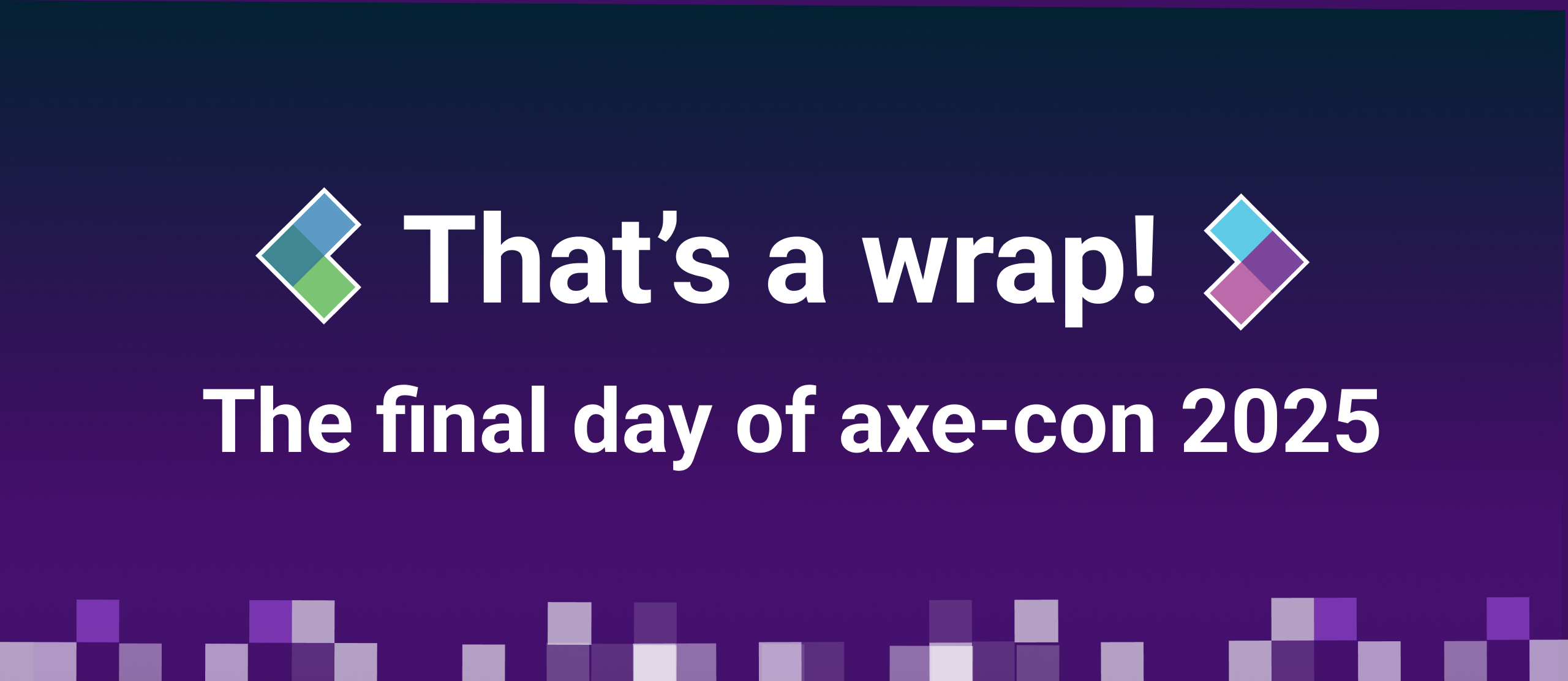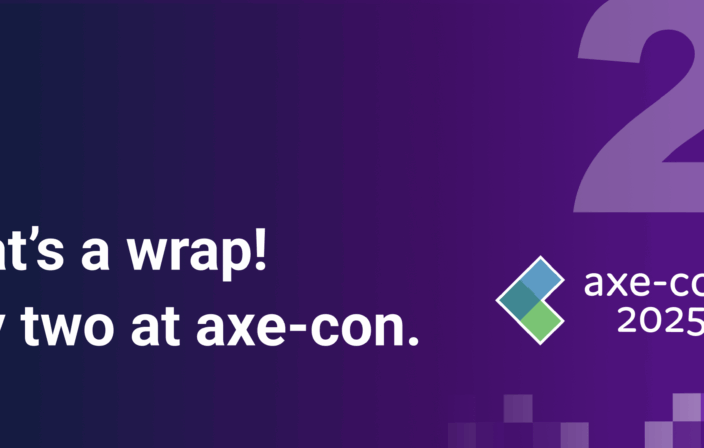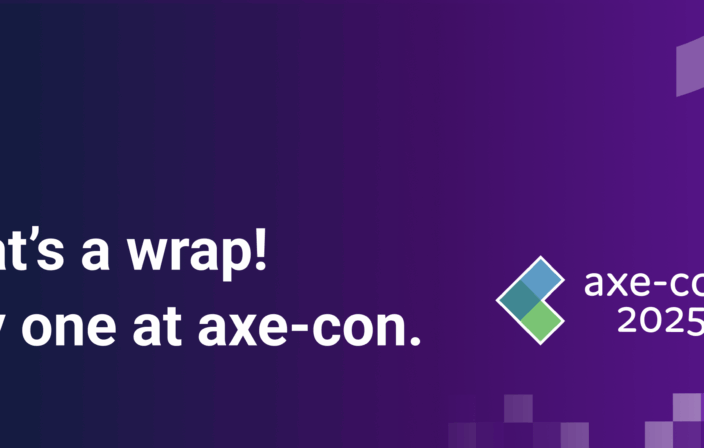Today was indeed the final day of axe-con 2025. Yet, while there are no more presentations on the calendar, an event like this doesn’t really end.
As each of you returns to your life and work, you carry with you the inspiration, the knowledge, and the power produced by this gathering. Every insight shared, every story told, every question asked and answered—you take it all with you. As an ambassador, advocate, ally, and leader, you carry the message and mission forward.
So, axe-con doesn’t really end. It just spreads outward, continuing to positively impact lives across the globe.
On behalf of all of us at Deque, we are so grateful to you. Axe-con only lasts for three days. Your passion and dedication are timeless.
But look at us, already sounding like we’re saying goodbye when we haven’t even talked about today yet!
Axe-con sessions
With our closing keynote coming at the end of the day’s happenings, we got started first thing with four concurrent sessions:
- Typographer vs. Accessibility
- Axe innovations: AI in next-gen accessibility tools
- The Digital Accessibility Legal Landscape
- It is designed to break your heart: Cultivating a harm reduction mindset as an accessibility practitioner
These first four sessions spanned an impressive range, and not just of topics, but also emotions.
It was clear, for example, that attendees really appreciated the energy and humor Oliver Schöndorfer brought to his presentation on typography. From the chat:
“This is exactly the delivery style I need at 9am US Eastern time (not a morning person, and this is amazing).”
“Really needed this type of energy in my life today. I love this already.”
“Oliver is hilarious.”
And humans weren’t the only ones appreciating Oliver’s approach!
“It’s 6 am here in California, and my cat is on my desk transfixed!”
Now, while Oliver may have used humor and personality to keep everyone engaged …

… he also offered highly detailed insight and guidance as well:
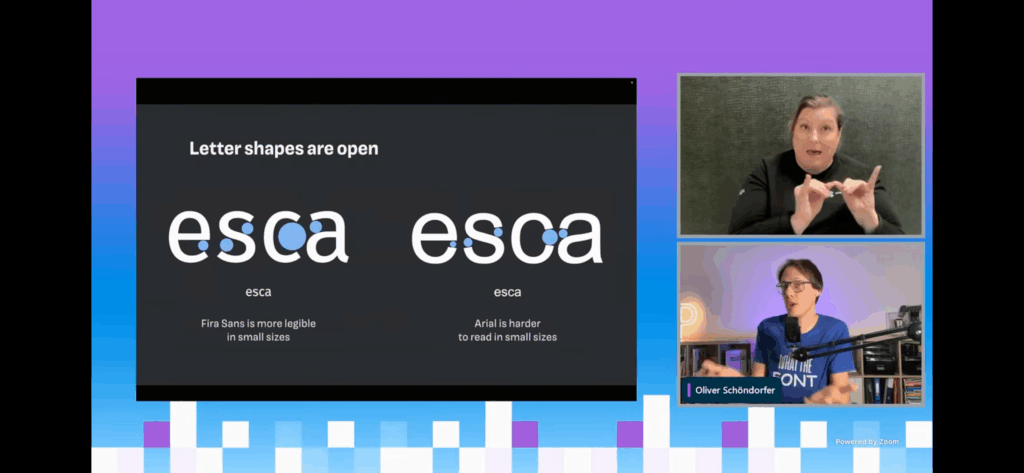
Detailed and actionable guidance was also definitely the name of the game as Wilco and Noé discussed AI and next-gen accessibility tools:

The next two sessions were both an intense study in contrast and a testament to the shared complexity that exists across accessibility issues.
While you could say that Lainey Feingold took on the legal side and Eric Bailey addressed the human element, the truth is that both sessions involved deep engagement with both policy and people:


As attendees headed for the second round of sessions, we were all looking forward to hearing about everything from social media to human-centered design!
- Accessibility in the age of social media influence
- The State of Mobile App Accessibility in 2025
- Considering the ‘Human’ in Human-Centered Design
- Digital Accessibility as a Professional Responsibility: People, Product, Process and Positioning
Wondering why we’re including all the links? It’s because all registrants get on-demand access to the session videos! We know you can’t attend all four sessions at once, so we make sure you have the chance to check them all out afterward.
As the conference has progressed, there have been a number of themes that have emerged. One of these has to do with change and our collective power to drive it. Maya Sellon, in her presentation on human-centered design, synthesized the sentiment beautifully:

We concluded yesterday’s recap with a quote about seemingly small actions having a big impact, and a session in the third round—which was about cookie notices (Designing consent: how accessible are cookie notices?)—offered a perfect example of this. If you didn’t start out believing that those little notices are super important, you definitely felt that way by the end of the session!
“A friend is somebody you trust. So the first thing you have to do is to build trust with users.” – Sara Kjellstrand, Research Strategist, Funka Foundation
Having said all that, another session in the third round was all about BIG. Big, as in, the biggest thing to happen in accessibility in ages. We mean, of course, the European Accessibility Act (EAA)!

In her presentation (Implementation of EAA in a state-owned enterprise), we loved how Hanna reminded us that big transformation deserves a big celebration!

We’ve mentioned many times that accessibility professionals are a crucial part of the axe-con community and a critical force in moving the mission of accessibility forward. Which is why we always include sessions designed to help and support advocates and professionals in the field.
Judging by the response in Discord to Influencing Without Authority: A Pep Talk for Accessibility Advocates, Kai Wong’s session meant a great deal to the community. Here’s one Discord comment that perfectly sums it up:
“Such a powerful, uplifting session!! I would tune in for a Kai Wong chat daily if I could! Thank you!”
Kai had such great guidance to offer throughout the session:
“Empathy is a skill, and the ways you can build it is by getting to know people with disabilities, by going out and learning about different types of people.” – Kai Wong, Principal, Digital Accessibility, Teladoc Health
Kai also delivered one of our absolute favorite quotes of the entire conference:

That’s exactly what we were talking about in the introduction of this recap, and it’s what axe-con is all about. Gaining and sharing knowledge, and then going out there and spreading that sauce!
Our next round of sessions touched on some highly informative topics, including:
- Accessible live regions (It’s Alive! Facing The Monsters Of Accessible Live Regions)
- Inclusive product design (Building for Everyone: The Power of HeuristIQ in Inclusive Product Design)
- The software development lifecycle (Building Accessibility into the Software Development Lifecycle: Roles and Responsibilities of the Project Team)
- Accessibility for connected devices (TV for All: Breaking Barriers to Accessibility on Connected Devices)
As with all axe-con sessions, there were some outstanding quotes to capture:


By this point in the day, we knew people would be starting to look ahead to the big closing keynote. Fortunately, we had an outstanding last round of sessions lined up to ensure that attendees were getting their money’s worth … wait a second! The conference is free!
Anyhow, as we said, we had four more great sessions lined up:
- WCAG 2 Mobile Update: How WCAG 2.2 applies to mobile apps
- Creating Inclusive Websites with Plain Language
- Holding Vendors Accountable – Designing your own accessibility vendor monitoring program
- Innovating Neuroinclusion: Building Accessible Digital Experiences for Neurodivergent Users
All four were incredible, and together, they served to reinforce why the work of accessibility is as much art as it is science.
Jay Brite reminded us of how cross-functional you have to be:
“Plain language is a balancing act. It’s more than just simplified language. You’re going to be balancing multiple accessibility, business, and user goals and trying to get to the most readable and accessible experience for everyone.” – Jay Brite, Content Strategist
While Jason Page highlighted the power of partnership:
“You’re partners in this process. Make that connection, and you could really develop a wonderful relationship.” – Jason Page, Accessibility Analyst & Vendor Program Lead, Navy Federal Credit Union
Jackie talked about embracing technology while centering humanity:
“AI is a mix. Use it, but you still need to be a human to check it and make sure that it’s doing the thing that you want it to do, and that it’s doing it well.” -Jackie Pysarchuk, Enterprise Content Strategist, American College of Cardiology
And Piper (who was wearing her “axe-con is for lovers of accessibility” shirt!) celebrated how accessibility promotes independence:
“Accessibility is helping with independence in a society that often places a deficit in being able to be accomplished.” – Piper Hutson, Professor, Lindenwood University
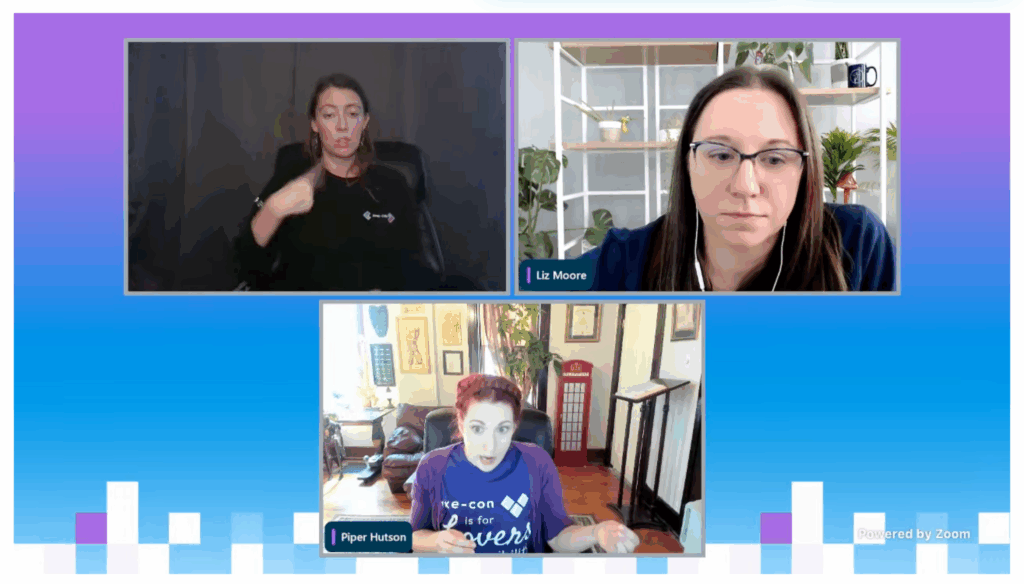
Making change happen
Making change happen was a constant theme through axe-con 2025, and our final keynote addressed the topic directly with a presentation devoted to the power of storytelling.
It’s no exaggeration to say that we were all pretty much giddy with excitement about this keynote. In the world of accessibility, the movie Crip Camp stands as a historical milestone, telling a story that had to be told, in a way that it had never been told before.
Jim LeBrecht, of course, is the co-director of Crip Camp, and he is a true legend, both creatively and as an advocate. His passion and humility were on immediate display right from the start:

Jim’s conversation with Patrick Sturdivant (Vice President and Principal Strategy Consultant, Deque) was wide-ranging, covering everything from his childhood education to the support Crip Camp received from the Obamas.
But if there was one moment that stood out above all the rest, it was probably this one:

It was a somber moment, and one that each of us felt deep in our guts, and deep in our hearts. But this is the reality of the work we all do and believe in. The world is not a perfect place. Not all humans are treated equally. Not everyone can enjoy the full measure of their civil rights. This is why we do what we do. Because we won’t rest until change happens.
And as Jim said, “We have the ability to make change.”
Looking ahead
As we say goodbye to axe-con 2025, we say hello to the future. And the future starts now.
We have work to do, and we’re going to do it. And we’re going to do it together, as a community. As one attendee wrote in Discord, “Community is the key to our survival! It has and always will be, especially now.”
Thank you all for attending axe-con 2025. Thank you for the work you do, and for being part of this community and this mission. As Glenda Sims said on day one, “You are part of this movement. Your voice, your work, your advocacy—it all matters.”
It all matters. Especially now.

